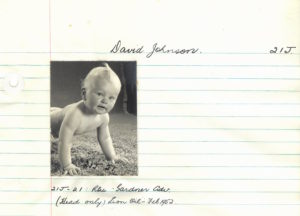|
|
Transcription: BETTER HOMES & GARDENS MEREDITH PUBLISHING COMPANY[7], DES MOINES 3, IOWA February 18, 1953 Dear Miss Nichols:[8] Since writing you that we were holding the four pictures in the 45-G[9] series, and sending you the confirming order which did not specify the exact picture number, my attention has been called to the Playtex Dryper ad which appeared in the December 1, 1952 issue of Life[10] and probably in other publications.[11] Apparently it was the picture illustrating that ad which stuck to the memory of several of us leading to our telegraphed inquery [sic] as to whether or not any of your 45-G series had been published previously. I have just discussed with Noble Gammell, my Art Editor[12], the question of whether or not the picture we had selected from your 45-G series is too much like the Playtex ad. He has decided that it is and that we should not go ahead with our purchase of it. Playtex may repeat this ad at some time in the future and possibly it would be appearing just about the time we would publish our picture.  Source: Series XIII. Photographs, Box 5. Nichols Family Papers, RG 30/372. O.C.A. Therefore, Mr. Gammell requests that you mail back the selection of pictures of crawling babies which we returned to you on February 9. We will make another choice from that selection of pictures and we will let you know which picture we have chosen. At that time I will have our Art Department write you specifying the picture and what rights we wish to purchase. I will appreciate receiving the selection of pictures in the near future. Please advise if you wish us to return the four 45-G pictures we retained in advance of sending back the entire selection. Otherwise, we will return all of the photographs at one time. Sincerely, [signed in ink: Ann Usher][13] Associate Editor, Director Child Care and Training Dept. Mrs. Ann Usher mls[14] Miss Ruth A. Nichols 211 Chestnut Street Westfield, New Jersey [Transcribed by Willa Kerkhoff.] |
[1] Student File, Ruth Alexander Nichols, Record Group 28/2, Box 57, O.C.A.
[2] Usher previously worked as the Director of the Child Care and Training Department at Better Homes and Gardens. (“Better Homes and Gardens Baby Book – 5th …” Better Homes and Gardens Baby Book. Accessed 16 March 2016. Web link).
[3] Kathleen L. Endres and Therese L. Lueck, eds. Women’s Periodicals in the United States: Consumer Magazines. Historical Guides to the World’s Periodicals and Newspapers. (Westport, Conn: Greenwood Press, 1995), 22.
[4] Endres and Lueck, Women Periodicals, 22.; Carol Reuss, “Chesla C. Sherlock as First Editor of Better Homes and Gardens.” Books at Iowa 17, November 1972. Web link.
[6] Betty Friedan, The Feminine Mystique. (New York: W.W. Norton & Company, Inc, 1963).
[7] The Meredith Corporation remains the managing publisher of Better Homes and Gardens today.
[8] This is likely a typo as, in earlier letters, Usher referred to Ruth as Mrs. Nichols, which would have been the correct etiquette (“27. Notes and Shorter Letters. Post, Emily. 1922. Etiquette.” Accessed 22 June 2016.Web link).
[9] 45- G series probably refers to Nichols’ method of organizing her work. She assigned each child model a number, and then followed that with the letter of their last name. This was likely a long series of photographs involving one particular model.
[10] Life magazine.
[11] The ad’s tagline read “ Playtex Babies are Happier Babies- neater…sweeter…cleaner…cooler.” Later it also states that Playtex will keep your babies “socially acceptable” alluding to the domestic ideals of the era (“1952 AD Playtex Dryper Pads Panty Babies Diaper Cream Original Advertising LF3 | eBay.” Accessed 27 June 2016. Web link).
[12] Noble Gammell (1920-2013) served in the US Army until he received an honorable discharge. He then began working as the Art Editor for Better Homes and Gardens, a position which he held for many years. In 1942 he married Shirley Larson, with whom he had four children (“Noble F. Gammell,” Brian Mark Funeral Home. Accessed 17 March 2016. Web link).
[13] Ann Usher (b. 1909), who also appears to have gone by Anna, was an editor for Better Homes and Gardens. She was married to T. Raymond Usher (b. 1905) and the pair lived together in Des Moines, Iowa, where BH&G was headquartered. Despite Anne’s editorial position, their census records seem to indicate that her husband was the primary breadwinner: he was a medical doctor with a private practice. They were both white: Raymond had attended college and medical school, while Ann only finished high school. They had at least one child together, Ellen Ann Usher, who was born in 1934. In addition to her work as an editor, Ann Usher also appears to have written several articles for magazine. Some, including a work on the effects of T.V. on children, a babysitters’ “Bill of Rights,” and an article entitled “How your baby learns to think” seem firmly planted in the traditional domestic sphere; however she also wrote an article on the effects smoking in 1958 that might have pushed a bit beyond that traditional sphere (“U.S. City Directories, 1822-1995 – AncestryLibrary.com.” Accessed 22 June 2016. Web link.; “1940 United States Federal Census – AncestryLibrary.com.” Accessed 22 June 2016. Web link.;“1940 United States Federal Census – AncestryLibrary.com.” Accessed 22 June 2016. Web link.; Miriam Forman-Brunell, Babysitter: An American History. NYU Press, 2011.; “Better Homes And Gardens Magazine : May 1948, Vol. 26 Number 9 Issue – Schroeder, Ralph M. / Huttenlocher, Fae / Hendricks, J. Evans / Foster, Harry T. (Stories By).” Accessed 22 June 2016. Web link.; Patricia Mellencamp, Logics of Television: Essays in Cultural Criticism. (Indiana University Press, 1990).; “Some Facts About Smoking – Gospel Guardian vol.14, no.46, pg.2,11a.” Accessed 22 June 2016. Web link).
[14]These lower case letters likely are the initials of the typist who produced this letter, and others, for Usher.
